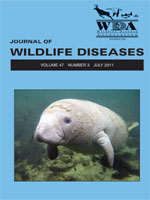From October 2009 through July 2010, five captive, 3-yr-old, female Rocky Mountain elk (Cervus elaphus) and nine free-ranging elk (one male, eight female) were immobilized with 0.1 mg/kg sufentanil plus 0.5 mg/kg xylazine which was antagonized with 1 mg/kg naltrexone and 2 mg/kg tolazoline. Induction and recovery times averaged 4.9±0.3 min and 3.9±0.4 min, respectively. Physiologic and blood gas parameters as well as bispectral index (BIS) were measured on the captive elk every 10 min for 30 min. Immobilization induced profound hypoxemia via hypoventilation and ventilation-perfusion mismatching as demonstrated by depressed partial pressure of arterial oxygen (PaO2) and increased partial pressure of arterial carbon dioxide (PaCO2). The only values to significantly (P<0.05) change over time were base excess (BE), bicarbonate (HCO3), and lactate. Bispectral index is a measure of anesthetic depth. The average BIS value over the 30 min period (59.1±2.4) was higher than the BIS value at the approximate point where elk lose consciousness, which indicated that this drug combination produced neuroleptanalgesia but not general anesthesia. Sufentanil and xylazine provided effective remote immobilization in elk and could be substituted for carfentanil or thiafentanil and xylazine should the need arise.
How to translate text using browser tools
1 July 2011
SUFENTANIL AND XYLAZINE IMMOBILIZATION OF ROCKY MOUNTAIN ELK
Terry J. Kreeger,
Matthew Huizenga,
Cole Hansen,
Benjamin L. Wise
ACCESS THE FULL ARTICLE

Journal of Wildlife Diseases
Vol. 47 • No. 3
July 2011
Vol. 47 • No. 3
July 2011
bispectral index
carfentanil
Cervus elaphus
immobilization
sufentanil
thiafentanil
Wyoming




